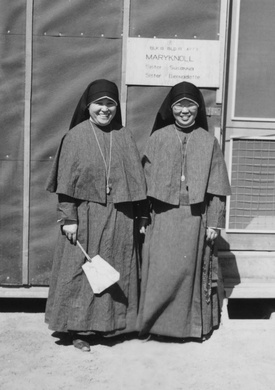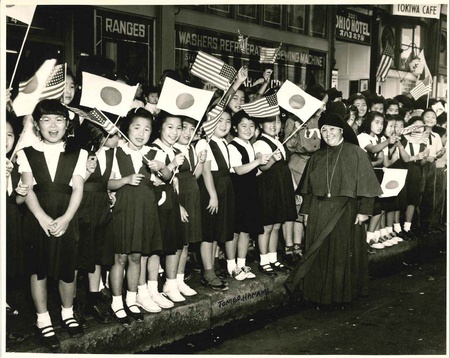As I have noted in my previous articles on the work of Fathers Leopold Tibesar and Hugh Lavery, a number of Maryknoll clergy played important roles in support of Japanese American communities in West Coast cities. Although priests like Lavery and Tibesar are remembered for their leadership during the incarceration, less known though equally important is the work of Maryknoll’s nuns.
Serving as teachers for the Maryknoll school and nurses at the Monrovia Maryknoll Sanitarium, the Maryknoll sisters were responsible for the everyday operations of Maryknoll’s activities among Japanese Americans. In fact, some of the first Japanese Americans to take vows as Catholic clergy were the nuns of Maryknoll.
Two particular nuns that actively worked with the communities of Los Angeles and Manzanar were sisters Mary Bernadette Yoshimochi and Susanna Hayashi. Although they came from separate social backgrounds, their work for Maryknoll in Los Angeles and the camp school at Manzanar reflected their devotion to the community.
Both Sisters Bernadette and Susanna began their lives in Japan. Sister Mary Bernadette Yoshimochi was born Sute Yoshimochi on October 5, 1901 in Shigaken, Japan. Little is known about her early childhood; her father died when she was 15, and her mother remained in Japan until her death in 1945.
At age 20, she left Japan for North America, formally arriving in the United States in December 1921. Initially arriving in Vancouver, British Columbia, she crossed the border into the U.S. and arrived in Seattle. There, she found work as a housekeeper with a French-Canadian Catholic woman and began visiting the Catholic church with her employer. Following her baptism, Sute Yoshimochi took the name Rose.
During Rose’s stay in Seattle, two nuns from Maryknoll arrived to work with Seattle’s Japanese American community. When they learned of Rose Yoshimochi’s devotion to the Catholic faith, they sought for her as a potential candidate for the Maryknoll order. Soon Rose began living with the nuns, and became convinced that the Maryknoll order was her calling.
On September 8, 1928, Rose Yoshimochi left Seattle to join the Maryknoll order in Ossining, New York. A year later, Rose Yoshimochi celebrated her formal Reception and took the name Mary Bernadette. After three years of training, Sister Bernadette Yoshimochi took vows as a nun on January 6, 1931, and began her assignment working with Japanese American tuberculosis patients at Maryknoll’s Monrovia Sanitarium.
For five years, Sister Mary Bernadette provided care and prepared meals for tuberculosis patients at the Maryknoll Sanitarium. In 1936, Maryknoll assigned Sister Bernadette to work among Japanese communities in Peng Yang (today’s Pyongyang, the capital of North Korea), then part of Japanese-occupied Korea and a center for Christian missionaries. In honor of her work for the Monrovia Sanitarium, Maryknoll honored Sister Bernadette with a farewell party commemorating her service on September 24. Those leaving the Maryknoll Mission of Los Angeles included Sister Benigna Rose, who was bound for the Philippines, and Father Leopold Tibesar, who left to assume control of the Seattle mission. Two days later, Sister Bernadette left Los Angeles on a ship bound for Yokohama.
After two years of missionary work in Korea, Sister Bernadette returned to Los Angeles in November 1938, where she continued her work with the Monrovia Sanitarium until Spring 1942.
On July 6, 1941, the Rafu Shimpo profiled a sixth Nikkei nun accepted to the Maryknoll order. Otome Hayashi was born in Hokkaido, Japan, on January 23, 1899. Otome received her education from a girl’s school in Hokkaido administered by the French Sisters of St. Maur. One of her childhood friends in Japan, Maryknoll Sister Marianna Akashi, wrote to Otome and convinced her to join the Maryknoll order.
In January 1924, Otome Hayashi arrived in Los Angeles, and entered the Maryknoll order on February 7. A year later, Otome Hayashi began her training as a nun at the Maryknoll Seminary in Ossining, New York, and received the Christian name Mary Susanna at her Reception. Three years later, on April 25, 1927, Sister Susanna made her vows and returned to Los Angeles to work as a teacher at the Maryknoll school.
For most of her prewar career, Sister Susanna remained a teacher at the Maryknoll school, where she taught Japanese language and preached Christian doctrine to new Issei immigrants. Sister Susanna underlined the importance of education in particular to young Nisei children. On September 12, 1936, Sister Susanna spoke on a Japanese language program on KRKD, a Los Angeles radio network, about the importance of Catholic education in building good character. Although Sister Susanna made occasional trips to Japan, her entire prewar career was spent in Los Angeles at the Maryknoll School.

As with the rest of the Maryknoll community, Executive Order 9066 uprooted the Maryknoll sisters of Los Angeles. When the government informed Sisters Bernadette and Susanna of the ensuing removal, the Maryknoll order offered the nuns the option of returning to the Maryknoll Seminary in Ossining, instead of facing incarceration. Refusing to separate from their congregation, Sisters Bernadette and Susanna followed their Japanese American parishioners to Manzanar, where they remained for the duration of the war.
As with other inmates, the Sisters had trouble adjusting to camp life. Mary Ichino Suzuki, a former Manzanar incarceree and Maryknoll student, recalled both Sisters Bernadette and Susanna struggled over living in close quarters, and were embarrassed about using communal showers until a separate section was created.
Throughout their time at Manzanar, Sisters Bernadette and Susanna worked together to maintain the operations of the Catholic Church. Both nuns also cared for fifty orphans that originated from Maryknoll’s orphanage in the “Children’s Village” of the camp. Although the sisters could not celebrate mass (the work of priests like Father Lavery or Swift), Sisters Bernadette and Susanna provided Sunday school classes for students, and helped organize activities for children such as picnics.
On two occasions in 1944, the Sisters left camp for retreats at the Maryknoll center in Los Angeles. Because exclusion remained formally in place, the Sisters had to receive special authorization to return, and travelled to Los Angeles under escort. On Easter Sunday, April 8, 1945, the Sisters distributed baskets to patients at the Manzanar hospital.
Both sisters remained at Manzanar until the closure of the camp, leaving for Los Angeles on November 22, 1945. Both then returned to work at the Maryknoll mission in Los Angeles, where Sister Susanna continued teaching Japanese. In 1950, she departed for Japan, where she took an assignment working in the port city of Tsu. She frequently returned to the United States during these years, and eventually became a U.S. citizen in 1961. After nine more years of service in Japan, Sister Susanna returned to the United States permanently, and formally retired in 1970. Sister Susanna Hayashi died on May 27, 1984.
Sister Bernadette remained in Los Angeles, where she worked as a devout community worker who aided the sick and poor of Little Tokyo. At the same time, she worked at the Maryknoll school, where she helped provide school lunches for students and organized events for obon and the school’s annual St. Patrick’s Day dinners. At one point, Sister Bernadette began a Maryknoll school karate club, and invited Shotokan Karate master Tsutomu Ohshima.

In 1978, the Rafu Shimpo profiled Sister Bernadette as part of her golden jubilee for fifty years of service, noting her compassionate work with the Japanese American community through the incarceration. Sister Bernadette Yoshimochi retired in 1982, returning to the Monrovia seminary where her career began. She died on Christmas Day, 1989, at the age of 88.
In the years since the passing of the two Maryknoll sisters, members of the Japanese American community have memorialized both for their work in Los Angeles and at Manzanar. Pacific Citizen editor Harry Honda recalled in a letter to the Rafu Shimpo that Sister Susanna had taught him Japanese, and mentioned both nuns were a “common sight” for Japanese Americans at Manzanar in their veils and habits. In Jeanne Wakatsuki Houston and James Houston’s Farewell to Manzanar, both Sisters are portrayed as part of the camp community, with Bernadette as a “feisty, robust little Japanese Canadian who spoke both languages,” and Susanna a “frail, gentle Japanese woman from Japan who could speak no English.” Their service indicates how widespread the different forms of Catholic service to the Little Tokyo community were, and the honored place of religious women.
© 2021 Jonathan van Harmelen





